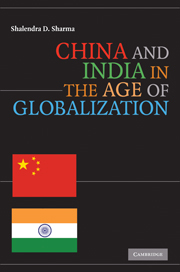Book contents
- Frontmatter
- Contents
- Acknowledgments
- Acronyms
- Political Map of China
- Political Map of India
- Introduction: China and India in the Age of Globalization
- 1 Prelude to Globalization: China (1949–1978) and India (1947–1991)
- 2 China and India Embrace Globalization
- 3 China: Strategies and Patterns of Global Integration
- 4 India: Strategies and Patterns of Global Integration
- 5 Sino-Indian Relations: Partners, Friends, or Rivals?
- 6 India and the United States: From Estrangement to Engagement
- 7 The Rise of China and Its Implications for the United States
- 8 China and India: Future Challenges and Opportunities
- Bibliography
- Index
4 - India: Strategies and Patterns of Global Integration
Published online by Cambridge University Press: 22 January 2010
- Frontmatter
- Contents
- Acknowledgments
- Acronyms
- Political Map of China
- Political Map of India
- Introduction: China and India in the Age of Globalization
- 1 Prelude to Globalization: China (1949–1978) and India (1947–1991)
- 2 China and India Embrace Globalization
- 3 China: Strategies and Patterns of Global Integration
- 4 India: Strategies and Patterns of Global Integration
- 5 Sino-Indian Relations: Partners, Friends, or Rivals?
- 6 India and the United States: From Estrangement to Engagement
- 7 The Rise of China and Its Implications for the United States
- 8 China and India: Future Challenges and Opportunities
- Bibliography
- Index
Summary
It is hard to miss the mood of optimism in contemporary India. Celebrating its sixtieth year of independence, the country's political and business leaders can hardly contain themselves, trumpeting India's economic achievements and its rise to global prominence. If in an earlier time India was patronizingly dismissed as “the country of the future,” forever poised for a dramatic takeoff but never quite accomplishing it, today its representatives, like effervescent Commerce and Industry Minister Kamal Nath, confidently proclaim that “we no longer discuss the future of India. The future is India.” No doubt, India has shed its image as a land of grinding poverty, starving children, sacred cows, and wandering holy men. Now media stories are about its legions of “techies,” savvy entrepreneurs, brand-name multinationals moving or outsourcing their operations to Bangalore, the ever-growing ranks of Indian business tycoons adding to their global portfolios, and the extravagant Bollywood movies. When the Indian industrial conglomerate Tata (with ninety-eight companies spanning a variety of industries) recently took over Corus, a major Belgian steel firm for US$11 billion, and Mittal Steel merged with Arcelor, making Arcelor Mittal the largest steel maker in the world; when the Indian conglomerate Aditya Birla Group purchased the American firm Novelis, the world's leading manufacturer of aluminum products; and, last but not least, when on 26 March 2008, Tata Motors of the Tata Group paid US$2.3 billion for Ford Motor Companies Jaguar and Land Rover brands, they were widely celebrated as conquering heroes – symbols of the “new India” finally taking their rightful place in the world.
- Type
- Chapter
- Information
- China and India in the Age of Globalization , pp. 131 - 163Publisher: Cambridge University PressPrint publication year: 2009



